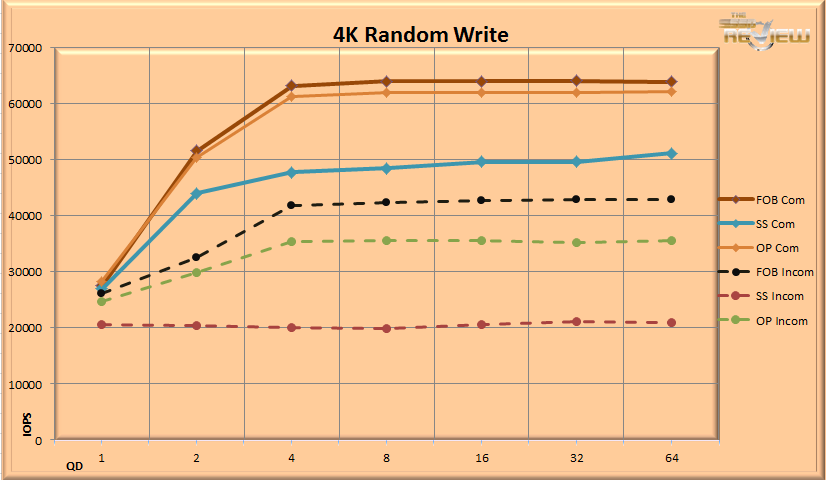RANDOM WRITE MEASUREMENTS
The Random Write speed can be very telling for performance in real environments. Mixed Read/Write workloads can become very dependent upon the write speed that is sustainable over a period of time. We will also begin delving into the difference between FOB (Fresh Out of Box), Steady State (SS), and 20% over provisioned (OP) execution.
We also begin to compare Compressible data and Incompressible data performance now with the LSI SandForce SSDs. LSI SandForce SSDs rely upon compression for some of the performance advantages that they have. The compressibility of the data of each workload can vary tremendously depending upon the type of data used, and here SandForce drives have an advantage, as most enterprise data is very compressible.
It is extremely important for users to know their workload, and tune the SSD accordingly. We are testing with 100% compressible data, represented as solid lines, and Full Random data, represented as the dashed lines, which cannot be compressed. Data in some deployments will have varying levels of compressibility, so the performance may vary, and reside between these two values for semi-compressible data.
FOB testing consists of an 8GB LBA. The Steady State testing is conducted at 100% fill capacity, and utilizes full span writes. This is truly the torture test and gives an accurate picture of the SSD under the most demanding circumstances. 20% OP testing consists of 20% of the drive being left unformatted. The formatted region is filled to capacity, and written to full span.
The 4k Random Write speeds are very good, topping out at 62,000 IOPS for FOB, and 52,000 IOPS with regular steady state. With the Over-Provisioning, there is a gain up over 60,000 IOPS in steady state.
 The 128K random writes also fare very well, with compressible data they come in just shy of 500MB/s.
The 128K random writes also fare very well, with compressible data they come in just shy of 500MB/s.
Power consumption is always a big deal in the server environment for several reasons. Providing power, and redundancy for that power, is a very expensive proposition and the highest ongoing expense for any enterprise application. Power consumption also equates to heat production, which in turn requires more power to effectively dissipate via active cooling solutions.
SSDs in general fare well in this area, with some being more effective than others. Two key measurements are most often mentioned when discussing the power requirements of any Storage device, that being idle and start-up power consumption. Idle highlights the theoretical minimum power draw, while start-up represents the other end of that spectrum. The start-up power for the SSD is relatively good at 3.02. The Idle power draw is a tad high at 1.67, but still within range of some of the heavy usage SSDs.
 We can observe the power consumption across a wide variety of our tests here. The OWC SSD performs within the same range as other competitors with this type of overall drive performance values.
We can observe the power consumption across a wide variety of our tests here. The OWC SSD performs within the same range as other competitors with this type of overall drive performance values.

 The IOPS per Watt measurements below take the performance of the SSD at QD32 compared to the amount of wattage that we recorded being consumed. The OWC scores very well in IOPS/Watts, with 10,134 for the 4K read IOPS when measured with compressible data. Bear in mind that read speeds do not vary by wide margins with incompressible data. With the 4k Write IOPS we do see more variability between the IOPS/Watts numbers. The lower numbers are more in line with other SSDs, with even the 4k Steady State Write being very high with incompressible data. Factoring in the compression, the values are excellent across the boards for writes.
The IOPS per Watt measurements below take the performance of the SSD at QD32 compared to the amount of wattage that we recorded being consumed. The OWC scores very well in IOPS/Watts, with 10,134 for the 4K read IOPS when measured with compressible data. Bear in mind that read speeds do not vary by wide margins with incompressible data. With the 4k Write IOPS we do see more variability between the IOPS/Watts numbers. The lower numbers are more in line with other SSDs, with even the 4k Steady State Write being very high with incompressible data. Factoring in the compression, the values are excellent across the boards for writes.
 The SSD Review The Worlds Dedicated SSD Education and Review Resource |
The SSD Review The Worlds Dedicated SSD Education and Review Resource | 
That is the drive I want on my web server!
We bought 16 of these drives. We have had 12 fail and are working on RMA-ing them. No apologies from OWC. Just saying.